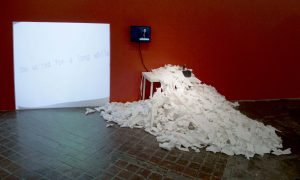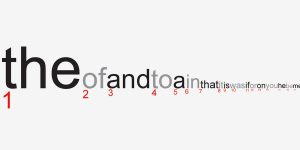//Michelle Janco
//mjanco@andrew.cmu.edu
//Final Project - Section B
var fish = [];
var tree = .05;
var treeSpeed = .0009;
var lX = 300;
var song;
//yellow sky color
var yellowSkyR = 240;
var yellowSkyG = 215;
var yellowSkyB = 87;
//new sky color
var skyR = 217;
var skyG = 98;
var skyB = 88;
function setup() {
createCanvas(640, 240);
// create fish
for (var i = 0; i < 5; i++){
var rx = random(width);
fish[i] = makefish(rx);
}
frameRate(30);
}
function draw() {
background(yellowSkyR, yellowSkyG, yellowSkyB);
displayHorizon();
makeTree();
updateAndDisplayfish();
removefishThatAreOutOfView();
addNewfishWithSomeRandomProbability();
//change background color as mouse
//moves across canvas
if ((mouseX >= 640) & (mouseX <=640)){
mouseX = 640;
}
if ((mouseX > 0) & (mouseX < 640)){
yellowSkyR = mouseX*((217-240)/640) + 240;
yellowSkyG = mouseX*((98-215)/640) + 215;
yellowSkyB = mouseX*((88-87)/640) + 87;
}
//big cloud
fill(255);
ellipse(mouseX + 5, 55, 20);
ellipse(mouseX + 25, 50, 35);
ellipse(mouseX + 40, 60, 25);
ellipse(mouseX + 55, 50, 40);
ellipse(mouseX + 80, 50, 25);
ellipse(mouseX + 95, 55, 15);
//smaller cloud
fill(255);
ellipse(mouseX + 68, 10, 10);
ellipse(mouseX + 80, 10, 20);
ellipse(mouseX + 95, 10, 25);
ellipse(mouseX + 110, 10, 30);
ellipse(mouseX + 125, 8, 30);
ellipse(mouseX + 140, 10, 15);
ellipse(mouseX + 145, 10, 10);
//smallest cloud
fill(255);
ellipse(mouseX + 268, 40, 10);
ellipse(mouseX + 280, 40, 20);
ellipse(mouseX + 295, 40, 25);
ellipse(mouseX + 310, 40, 40);
ellipse(mouseX + 325, 38, 30);
ellipse(mouseX + 340, 40, 15);
ellipse(mouseX + 345, 40, 10);
}
function mouseClicked() {
//if mouse is inside sun, draw text
var d = dist(mouseX, mouseY, 550, 50);
if (d < 100) {
showText(true);
}
}
function showText(mouse) {
if (mouse==true) {
textSize(32);
fill(0);
text("Salmon Skies", 20, 50);
}
}
//make trees
function makeTree() {
noStroke();
fill(22, 60, 28);
beginShape();
for (var i = 0; i < width; i++) {
var x = (i * tree) + (millis() * treeSpeed);
var y = map(noise(x), 0, 1, height/2, height/3);
vertex(i, y);
}
vertex(width, height-height/2);
vertex(0, height-height/2);
endShape();
}
function displayHorizon() {
noStroke();
line(0,height-height/2, width, height-height/2);
//pond
fill(44, 80, 108);
rect(0, height-height/2, width, height-height/2);
//sun
fill(240);
noStroke();
ellipse(550, 50, 50, 50);
}
function updateAndDisplayfish(){
// update fish positions, display them
for (var i = 0; i < fish.length; i++){
fish[i].move();
fish[i].display();
}
}
function removefishThatAreOutOfView(){
//if entirety of the fish are off canvas
//then remove them
var fishToKeep = [];
for (var i = 0; i < fish.length; i++){
if (fish[i].x + fish[i].breadth > 0) {
fishToKeep.push(fish[i]);
}
}
fish = fishToKeep;
}
function addNewfishWithSomeRandomProbability() {
//small probability, add a new fish to the end
var newfishLikelihood = 0.005;
if (random(0,1) < newfishLikelihood) {
fish.push(makefish(width));
}
}
//update position of fish
function fishMove() {
this.x += this.speed;
}
//draw the fish
function fishDisplay() {
var fishHeight = random(10, 15);
var fHeight = (20);
fill(219, 97, 87, 150);
noStroke();
push();
translate(this.x, height - 60);
//fish body
ellipse(0, -fHeight, this.breadth, fishHeight);
fill(255);
//fish eyes
ellipse(-13, -fHeight, 4, 6);
fill(0);
ellipse(-13, -fHeight, 2, 3);
//fish fins
fill(219, 97, 87, 150);
ellipse(0, -fHeight+7, 4, 8);
fill(219, 97, 87, 150);
ellipse(-2, -fHeight-7, 6, 8);
fill(219, 97, 87, 150);
arc(23, -fHeight, 30, 30, 0, HALF_PI);
//fish reflection
fill(219, 97, 87, 30);
ellipse(0, fHeight, this.breadth, fishHeight);
//reflection fish eyes
fill(255, 30);
ellipse(-13, fHeight, 4, 6);
fill(0, 30);
ellipse(-13, fHeight, 2, 3);
//reflection fish fins
fill(219, 97, 87, 30);
ellipse(0, fHeight+7, 4, 8);
fill(219, 97, 87, 30);
ellipse(-2, fHeight-7, 6, 8);
fill(219, 97, 87, 30);
arc(23, fHeight, 30, 30, 0, HALF_PI)
pop();
}
function makefish(birthLocationX) {
var fis = {x: birthLocationX,
breadth: 50,
speed: -2.0,
nlil: round(random(2,40)),
move: fishMove,
display: fishDisplay}
return fis;
}
For this project, I wanted to go back to a concept that I struggled with. During the generative landscape project, I ran into quite a few problems and was not able to make an image that I found aesthetically pleasing. I wanted to return to this, and have more time to work through the concepts to be able to make something calming to watch. I am drawn to imagery that relaxes the viewer, and I imagine this is the type of image that could be watched to slow down a person’s heart rate, as the fish move at a calming pace. I love going to the lake back home with my Dad and watching the fish go by, which was always a therapeutic activity. This image in my head was what I wanted to emulate. Considering the amount of difficulty and trouble I have faced in this class, I’m glad I had extra time to really focus, take my time, and make something that feels fairly complete. I learned a lot more skills from being able to slow down and focus on these concepts.
![[OLD FALL 2017] 15-104 • Introduction to Computing for Creative Practice](../../wp-content/uploads/2020/08/stop-banner.png)






